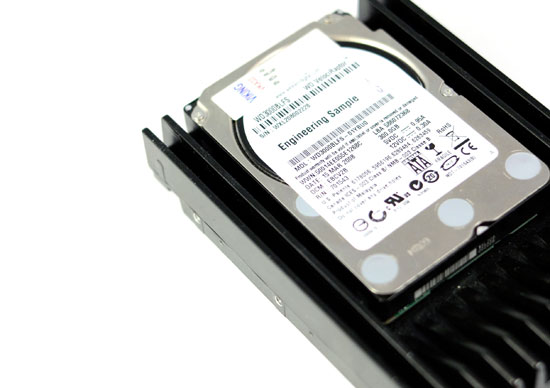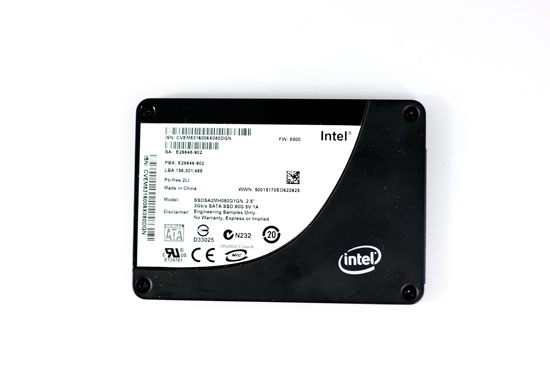The SSD Anthology: Understanding SSDs and New Drives from OCZ
by Anand Lal Shimpi on March 18, 2009 12:00 AM EST- Posted in
- Storage
Why You Should Want an SSD
For the past several months I’ve been calling SSDs the single most noticeable upgrade you can do to your computer. Whether desktop or laptop, stick a good SSD in there and you’ll notice the difference.
I’m always angered by the demos in any Steve Jobs keynote. Not because the demos themselves are somehow bad, but because Jobs always has a perfectly clean machine to run the demos on - and multiple machines at that. Anyone who has built a computer before knows the glory of a freshly installed system; everything just pops up on your screen. Applications, windows, everything - the system is just snappy.
Of course once you start installing more applications and have more things running in the background, your system stops being so snappy and you tend to just be thankful when it doesn’t crash.
A big part of the problem is that once you have more installed on your system, there are more applications sending read/write requests to your IO subsystem. While our CPUs and GPUs thrive on being fed massive amounts of data in parallel, our hard drives aren’t so appreciative of our multitasking demands. And this is where SSDs truly shine.
Before we go too far down the rabbit hole I want to share a few numbers with you.
This is Western Digital’s VelociRaptor. It’s a 300GB drive that spins its platters at 10,000RPM and is widely considered the world’s fastest consumer desktop hard drive.

The 300GB VelociRaptor costs about $0.77 per GB.
This is the Intel X25-M. The Conroe of the SSD world, the drive I reviewed last year. It costs about $4.29 per GB; that’s over 5x the VelociRaptor’s cost per GB.

The VelociRaptor is the dominant force in the consumer HDD industry and the X25-M is the svelte bullfighter of the SSD world.
Whenever anyone mentions a more affordable SSD you always get several detractors saying that you could easily buy 2 VelociRaptors for the same price. Allow me to show you one table that should change your opinion.
This is the Average Read Access test from Lavalys’ Everest Disk benchmark. The test simply writes a bunch of files at random places on the disk and measures how long it takes to access the files.
Measuring random access is very important because that’s what generally happens when you go to run an application while doing other things on your computer. It’s random access that feels the slowest on your machine.
| Random Read Latency in ms | |
| Intel X25-M | 0.11 ms |
| Western Digital VelociRaptor | 6.83 ms |
The world’s fastest consumer desktop hard drive, Western Digital’s 300GB VelociRaptor can access a random file somewhere on its platters in about 6.83ms; that’s pretty quick. Most hard drives will take closer to 8 or 9ms in this test. The Intel X25-M however? 0.11ms. The fastest SSDs can find the data you’re looking for in around 0.1ms. That’s an order of magnitude faster than the fastest hard drive on the market today.
The table is even more impressive when you realize that wherever the data is on your SSD, the read (and write) latency is the same. While HDDs are fastest when the data you want is in the vicinity of the read/write heads, all parts of a SSD are accessed the same way. If you want 4KB of data, regardless of where it is, you’ll get to it at the same speed from a SSD.
The table below looks at sequential read, sequential write and random write performance of these two kings of their respective castles. The speeds are in MB/s.
| Sequential Read (2MB Block) | Sequential Write (2MB Block) | Random Write (4KB Block) | |
| Intel X25-M | 230 MB/s | 71 MB/s | 23 MB/s |
| Western Digital VelociRaptor | 118 MB/s | 119 MB/s | 1.6 MB/s |
If you’re curious, these numbers are best case scenario for the VelociRaptor and worst case scenario for the X25-M (I’ll explain what that means later in the article). While the VelociRaptor is faster in the large block sequential writes look at the sequential read and random write performance. The X25-M destroys the VelociRaptor in sequential reads and is an order of magnitude greater in random write performance. If you’re curious, it’s the random write performance that you’re most likely to notice and that’s where a good SSD can really shine; you write 4KB files far more often than you do 2MB files while using your machine.
If the table above doesn’t convince you, let me share one more datapoint with you. Ever play World of Warcraft? What we’re looking at here is the amount of time it takes to get from the character selection screen into a realm with everything loaded. This is on a fully configured system with around 70GB of applications and data as well as real time anti-virus scanning going on in the background on every accessed file.
| WoW Enter Realm Time in Seconds | |
| Intel X25-M | 4.85 s |
| Western Digital VelociRaptor | 12.5 s |
The world’s fastest hard drive gets us into the game in 12.5 seconds. The Intel X25-M does it in under 5.
SSDs make Vista usable. It doesn’t matter how much background crunching the OS is doing, every application and game launches as if it were the only thing running on the machine. Everything launches quickly. Much faster than on a conventional hard drive. If you have the ability, try using your system with a SSD for a day then go back to your old hard drive; if that test doesn’t convince you, nothing will.
That’s just a small taste of why you’d want an SSD, now let’s get back to finding a good one.










250 Comments
View All Comments
zdzichu - Sunday, March 22, 2009 - link
Very nice and thorough article. I only lack more current status of TRIM command support in current operating systems. For example, Linux supports it since last year:http://kernelnewbies.org/Linux_2_6_28#head-a1a9591...">http://kernelnewbies.org/Linux_2_6_28#h...a9591f48...
Sinned - Sunday, March 22, 2009 - link
Outstanding article that really helped me understand SSD drives. I wonder how much of an impact the new SATA III standard will have on SSD drives? I believe we are still at the beginning stage for SSD drives and your article shows that much more work needs to be done. My respect for OCZ and how they responded in a positive and productive way should be a model for the rest of the SSD makers. Thank you again for such a concise article.Respectfully,
Sinned
529th - Sunday, March 22, 2009 - link
The first thing I thought of was Democracy. Don't know why. Maybe it was because a company listened to our common goal of performance. Thank you OCZ for listening, I'm sure it will pay off!!!araczynski - Saturday, March 21, 2009 - link
very nice read. the 4/512 issue seems a rather stupid design decision, or perhaps more likely a stupid problem to find this 4/512 solution as 'acceptable'.although a great marketing choice, built in automatic life expectancy reduction.
sounds like the manufacturers want the hard drives to become a disposable medium like styrofoam cups.
perhaps when they narrow the disparity down to 4/16, i might consider buying an ssd. that, or when they beat the 'old school' physical platters in price.
until then, get back to the drawing board and stop crapping out these half arsed 'should be good enough' solutions.
IntelUser2000 - Sunday, March 22, 2009 - link
araczynski: The 4/512 isn't done by accident. It's done to lower prices. The flash technology used in SSDs are meant to replace platter HDDs in the future. There's no way of doing that without cost reductions like these. Even with that the SSDs still cost several times more per storage space.araczynski - Tuesday, March 24, 2009 - link
i understand that, but i don't remember original hard drives being released and being slower than the floppy drives they were replacing.this is part of the 'release beta' products mentality and make the consumer pay for further development.
the 5.25" floppy was better than the huge floppy in all respects when it was released. the 3.5" floppy was better than the 5.25" floppy when it was released. the usb flash drives were better than the 3.5" floppies when they were released.
i just hate the way this is being played out at the consumer's expense.
hellcats - Saturday, March 21, 2009 - link
Anand,What a great article. I usually have to skip forwards when things bog down, but they never did with this long, but very informative article. Your focus on what matters to users is why I always check anandtech first thing every morning.
juraj - Saturday, March 21, 2009 - link
I'm curious what capacity is the OCZ Vertex drive reviewed. Is it an 120 / 250g drive or supposedly slower 30 / 60g one?Symbolics - Friday, March 20, 2009 - link
The method for generating "used" drives is flawed. For creating a true used drive, the spare blocks must be filled as well. Since this was not done, the results are biased towards the Intel drives with their generous amount of spare blocks that were *not* exhausted when producing the used state. An additional bias is introduced by the reduction of the IOmeter write test to 8 GB only. Perhaps there are enough spare blocks on the Intel drives so that these 8 GB can be written to "fresh" blocks without the need for (time-consuming) erase operations.Apart from these concerns, I enjoyed reading the article.
unknownError - Saturday, March 21, 2009 - link
I also just created an account to post, very nice article!Lots of good well thought out information, I'm so tired of synthetic benchmarks glad someone goes through the trouble to bench these things right (and appears to have the education to really understand them). Whats with the grammar police though? geez...